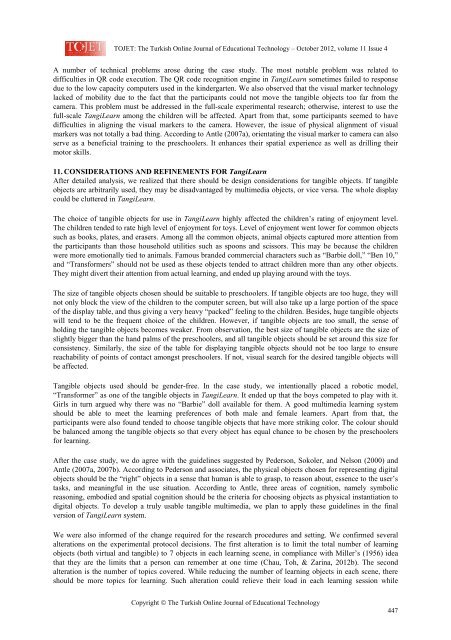october 2012 - TOJET the Turkish online journal of educational ...
october 2012 - TOJET the Turkish online journal of educational ...
october 2012 - TOJET the Turkish online journal of educational ...
Create successful ePaper yourself
Turn your PDF publications into a flip-book with our unique Google optimized e-Paper software.
<strong>TOJET</strong>: The <strong>Turkish</strong> Online Journal <strong>of</strong> Educational Technology – October <strong>2012</strong>, volume 11 Issue 4<br />
A number <strong>of</strong> technical problems arose during <strong>the</strong> case study. The most notable problem was related to<br />
difficulties in QR code execution. The QR code recognition engine in TangiLearn sometimes failed to response<br />
due to <strong>the</strong> low capacity computers used in <strong>the</strong> kindergarten. We also observed that <strong>the</strong> visual marker technology<br />
lacked <strong>of</strong> mobility due to <strong>the</strong> fact that <strong>the</strong> participants could not move <strong>the</strong> tangible objects too far from <strong>the</strong><br />
camera. This problem must be addressed in <strong>the</strong> full-scale experimental research; o<strong>the</strong>rwise, interest to use <strong>the</strong><br />
full-scale TangiLearn among <strong>the</strong> children will be affected. Apart from that, some participants seemed to have<br />
difficulties in aligning <strong>the</strong> visual markers to <strong>the</strong> camera. However, <strong>the</strong> issue <strong>of</strong> physical alignment <strong>of</strong> visual<br />
markers was not totally a bad thing. According to Antle (2007a), orientating <strong>the</strong> visual marker to camera can also<br />
serve as a beneficial training to <strong>the</strong> preschoolers. It enhances <strong>the</strong>ir spatial experience as well as drilling <strong>the</strong>ir<br />
motor skills.<br />
11. CONSIDERATIONS AND REFINEMENTS FOR TangiLearn<br />
After detailed analysis, we realized that <strong>the</strong>re should be design considerations for tangible objects. If tangible<br />
objects are arbitrarily used, <strong>the</strong>y may be disadvantaged by multimedia objects, or vice versa. The whole display<br />
could be cluttered in TangiLearn.<br />
The choice <strong>of</strong> tangible objects for use in TangiLearn highly affected <strong>the</strong> children’s rating <strong>of</strong> enjoyment level.<br />
The children tended to rate high level <strong>of</strong> enjoyment for toys. Level <strong>of</strong> enjoyment went lower for common objects<br />
such as books, plates, and erasers. Among all <strong>the</strong> common objects, animal objects captured more attention from<br />
<strong>the</strong> participants than those household utilities such as spoons and scissors. This may be because <strong>the</strong> children<br />
were more emotionally tied to animals. Famous branded commercial characters such as “Barbie doll,” “Ben 10,”<br />
and “Transformers” should not be used as <strong>the</strong>se objects tended to attract children more than any o<strong>the</strong>r objects.<br />
They might divert <strong>the</strong>ir attention from actual learning, and ended up playing around with <strong>the</strong> toys.<br />
The size <strong>of</strong> tangible objects chosen should be suitable to preschoolers. If tangible objects are too huge, <strong>the</strong>y will<br />
not only block <strong>the</strong> view <strong>of</strong> <strong>the</strong> children to <strong>the</strong> computer screen, but will also take up a large portion <strong>of</strong> <strong>the</strong> space<br />
<strong>of</strong> <strong>the</strong> display table, and thus giving a very heavy “packed” feeling to <strong>the</strong> children. Besides, huge tangible objects<br />
will tend to be <strong>the</strong> frequent choice <strong>of</strong> <strong>the</strong> children. However, if tangible objects are too small, <strong>the</strong> sense <strong>of</strong><br />
holding <strong>the</strong> tangible objects becomes weaker. From observation, <strong>the</strong> best size <strong>of</strong> tangible objects are <strong>the</strong> size <strong>of</strong><br />
slightly bigger than <strong>the</strong> hand palms <strong>of</strong> <strong>the</strong> preschoolers, and all tangible objects should be set around this size for<br />
consistency. Similarly, <strong>the</strong> size <strong>of</strong> <strong>the</strong> table for displaying tangible objects should not be too large to ensure<br />
reachability <strong>of</strong> points <strong>of</strong> contact amongst preschoolers. If not, visual search for <strong>the</strong> desired tangible objects will<br />
be affected.<br />
Tangible objects used should be gender-free. In <strong>the</strong> case study, we intentionally placed a robotic model,<br />
“Transformer” as one <strong>of</strong> <strong>the</strong> tangible objects in TangiLearn. It ended up that <strong>the</strong> boys competed to play with it.<br />
Girls in turn argued why <strong>the</strong>re was no “Barbie” doll available for <strong>the</strong>m. A good multimedia learning system<br />
should be able to meet <strong>the</strong> learning preferences <strong>of</strong> both male and female learners. Apart from that, <strong>the</strong><br />
participants were also found tended to choose tangible objects that have more striking color. The colour should<br />
be balanced among <strong>the</strong> tangible objects so that every object has equal chance to be chosen by <strong>the</strong> preschoolers<br />
for learning.<br />
After <strong>the</strong> case study, we do agree with <strong>the</strong> guidelines suggested by Pederson, Sokoler, and Nelson (2000) and<br />
Antle (2007a, 2007b). According to Pederson and associates, <strong>the</strong> physical objects chosen for representing digital<br />
objects should be <strong>the</strong> “right” objects in a sense that human is able to grasp, to reason about, essence to <strong>the</strong> user’s<br />
tasks, and meaningful in <strong>the</strong> use situation. According to Antle, three areas <strong>of</strong> cognition, namely symbolic<br />
reasoning, embodied and spatial cognition should be <strong>the</strong> criteria for choosing objects as physical instantiation to<br />
digital objects. To develop a truly usable tangible multimedia, we plan to apply <strong>the</strong>se guidelines in <strong>the</strong> final<br />
version <strong>of</strong> TangiLearn system.<br />
We were also informed <strong>of</strong> <strong>the</strong> change required for <strong>the</strong> research procedures and setting. We confirmed several<br />
alterations on <strong>the</strong> experimental protocol decisions. The first alteration is to limit <strong>the</strong> total number <strong>of</strong> learning<br />
objects (both virtual and tangible) to 7 objects in each learning scene, in compliance with Miller’s (1956) idea<br />
that <strong>the</strong>y are <strong>the</strong> limits that a person can remember at one time (Chau, Toh, & Zarina, <strong>2012</strong>b). The second<br />
alteration is <strong>the</strong> number <strong>of</strong> topics covered. While reducing <strong>the</strong> number <strong>of</strong> learning objects in each scene, <strong>the</strong>re<br />
should be more topics for learning. Such alteration could relieve <strong>the</strong>ir load in each learning session while<br />
Copyright © The <strong>Turkish</strong> Online Journal <strong>of</strong> Educational Technology<br />
447
















